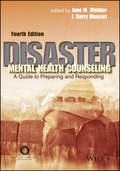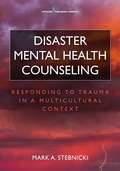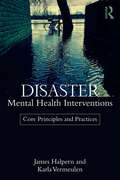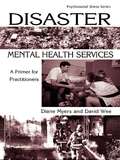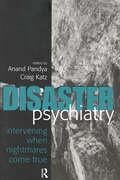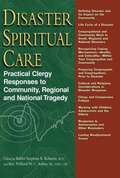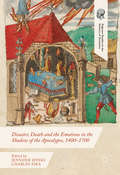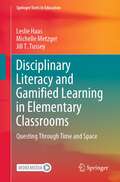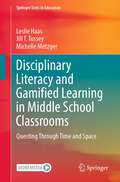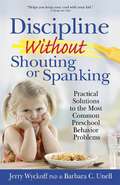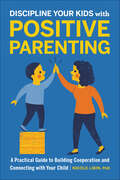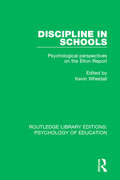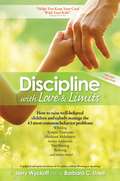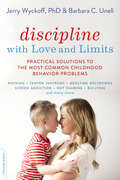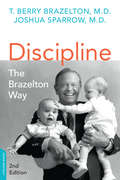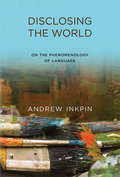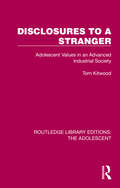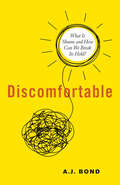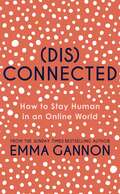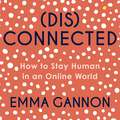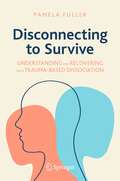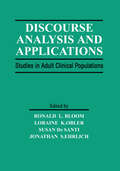- Table View
- List View
Disaster Mental Health Counseling: A Guide to Preparing and Responding
by Jane M. Webber J. Barry MascariThis timely book provides current research and skill-building information on Disaster Mental Health Counseling for counselors, educators, students, and mental health responders in agencies, schools, universities, and private practice. Recognized experts in the field detail effective clinical interventions with survivors in the immediate, intermediate, and long-term aftermath of traumatic events. This extensively revised edition, which meets 2016 CACREP Standards for disaster and trauma competencies, is divided into three sections: Disaster Mental Health Counseling Foundations, Disaster and Trauma Response in the Community, and Disasters and Mass Violence at Schools and Universities. Real-world responses to violence and tragedies among diverse populations in a variety of settings are presented, and responders share their personal stories and vital lessons learned through an "In Our Own Words" feature. Each chapter contains discussion questions and case studies are interwoven throughout the text. Requests for digital versions from the ACA can be found on wiley.com. To request print copies, please visit the ACA website here. Reproduction requests for material from books published by ACA should be directed to permissions@counseling.org
Disaster Mental Health Counseling: Responding to Trauma in a Multicultural Context
by Mark A. StebnickiConsiders disaster and mass trauma response from a culturally and globally relevant perspective--the first book of its kind, Addresses CACREP's clinical standards and content areas related to disaster mental health response, Covers many types of disasters and categories of survivors, Includes updated information on PTSD, complex trauma, and self-care, Addresses cultivating resiliency in individual and group survivors along with social justice issues, Offers an Instructor's Manual and PowerPoint slide packet for qualified adopters.
Disaster Mental Health Interventions: Core Principles and Practices
by James Halpern Karla VermeulenDisaster Mental Health Interventions uses DSM-5 diagnostic criteria and the latest research to help build disaster mental health intervention skills that will last a lifetime. Students and emerging professionals across the fields of mental health counseling, social work, school counseling, spiritual care, and emergency management will appreciate the accessible tone, level of detail, and emphasis on practice. Case studies and anecdotes from experienced professionals add an additional level of depth and interest for readers.
Disaster Mental Health Services: A Primer for Practitioners (Psychosocial Stress Series)
by Diane Myers David WeeDisaster mental health is a growing field of practice designed to help victims and relief workers learn to effectively cope with the extreme stresses they will face in the aftermath of a disaster. The goal of disaster mental health is to prevent the development of long-term, negative psychological consequences, such as PTSD. This book assists clinicians and traumatologists in "making the bridge" between their clinical knowledge and skills and the unique, complex, chaotic, and highly political field of disaster. It combines information from a vast reservoir of prior research and literature with the authors' practical and pragmatic experience in providing disaster mental health services in a wide variety of disasters.
Disaster Psychiatry: Intervening When Nightmares Come True
by Craig L. Katz Anand A PandyaDisaster Psychiatry: Intervening When Nightmares Come True captures the state of disaster psychiatry in the aftermath of the terrorist attacks of September 11, 2001. This emergent psychiatric specialty, which is increasingly separated from trauma and grief psychiatry on one hand and military psychiatry on the other, provides psychotherapeutic assistance to victims during, and in the weeks and months following, major disasters. As such, disaster psychiatrists must operate in the widely varying locales in which natural and man-made disasters occur, and they must establish their role among the chaotic array of organizations involved in direct disaster response. Editors Anand Pandya and Craig Katz have captured the challenge and promise of disaster psychiatry through first-person narratives. We hear from psychiatrists who have encountered disasters at various stages of their career and in widely varying social, political, and personal contexts. Accounts of psychiatric involvement with adults and children during and after 9/11 have understandable pride of place in this collection. But they are balanced by richly informative narratives about other domestic and international disasters. Fraught with the drama attendant to the events they describe, these essays delineate the dizzying array of challenges that confront the disaster psychiatrist. They range from the intense emotional responses that are part of the aftermath of any disaster, to the need to legitimize a psychiatric presence within diverse cultural and medical contexts, to the subtle task of providing therapeutic boundaries at a time when all rules seem to be suspended. Special attention is given to the daunting task of working with children whose parents' are disaster victims. What emerges from these testimonies is compelling documentation of skilled and compassionate psychiatrists at the outer limits of their specialty, pursuing their calling into uncharted realms of therapeutic engagement.
Disaster Spiritual Care: Practical Clergy Responses to Community, Regional and National Tragedy
by Willard W. C. Ashley Stephen B. RobertsThe first comprehensive resource for pastoral care in the face of disaster--a vital resource for clergy, seminarians, pastoral counselors and caregivers of all faith traditions. This essential resource for clergy and caregivers integrates the classic foundations of pastoral care with the unique challenges of disaster response on community, regional and national levels. Offering the latest theological perspectives and tools, along with basic theory and skills from the best disaster response texts, research and concepts, the contributors to this resource are innovators in their fields and represent Christianity, Judaism, Islam and more. Exploring how spiritual care changes following a disaster, and including a comprehensive explanation of a disaster's lifecycle, this is the definitive guidebook for counseling not only the victims of disaster but also the clergy and caregivers who are called to service in the wake of crisis.
Disaster, Death and the Emotions in the Shadow of the Apocalypse, 1400–1700
by Jennifer Spinks Charles ZikaIn late medieval and early modern Europe, textualand visual records of disaster and mass death allow us to encounter the intenseemotions generated through the religious, providential and apocalyptic frameworksthat provided these events with meaning. This collection brings togetherhistorians, art historians, and literary specialists in a cross-disciplinarycollection shaped by new developments in the history of emotions. It offers arich range of analytical frameworks and case studies, from the emotionallanguage of divine providence to individual and communal experiences ofdisaster. Geographically wide-ranging, the collection also analyses manydifferent sorts of media: from letters and diaries to broadsheets andpaintings. Through these and other historical records, the contributors examine how communities and individualsexperienced, responded to, recorded and managed the emotional dynamics andtrauma created by dramatic events like massacres, floods, fires, earthquakesand plagues.
Disaster: A Psychological Essay (International Library of Sociology)
by Martha WolfensteinFirst Published in 1998. Routledge is an imprint of Taylor & Francis, an informa company.
Disciplinary Literacy and Gamified Learning in Elementary Classrooms: Questing Through Time and Space (Springer Texts in Education)
by Leslie Haas Michelle Metzger Jill T. TusseyThis textbook provides real world examples of how disciplinary literacy can incorporate gamified learning opportunities in elementary classrooms (grades K-5 or ages 5-11). It also presents concrete examples of how to seamlessly integrate literacy within other subjects in engaging and unique ways. Furthermore, this text offers practical information related to pedagogy, content, and differentiation for each lesson. Preservice teachers, practicing teachers, instructional coaches, and administrators can benefit from this user-friendly text and its companion digital components, allowing for replication of lessons based on national standards, backed by best-practices, and supported by differentiated pedagogy.This unique volume begins with engineering marvels that span across centuries and locations. The eight chapters focus on the following marvels in chronological order: Great Pyramid of Giza, Stonehenge, Leaning Tower of Pisa, Great Wall of China, Machu Picchu, Panama Canal, Golden Gate Bridge, and International Space Station. By focusing on these specific examples of human ingenuity, opportunities are created to delve into the historical and social aspects of each chapter’s focus. There are also occasions to explore the artistic merit and the art created about and around each focus. Additional teaching opportunities lie in understanding the science, engineering, technology, and math embedded in all featured marvels.Each chapter features an adventure roadmap in the form of a narrative quest set against the chapter’s marvel that guides teachers and student players through embedded activities. Activities are designed for lower elementary school (grades K-2 or ages 5-8) and upper elementary school (grades 3-5 or ages 8-11). Instructional support for both novice and career teachers is provided through differentiation strategies, resource materials, and teaching tips.
Disciplinary Literacy and Gamified Learning in Middle School Classrooms: Questing Through Time and Space (Springer Texts in Education)
by Leslie Haas Michelle Metzger Jill T. TusseyThis textbook prepares teachers to incorporate gamified learning experiences into middle school classrooms. Its focus provides concrete examples of how to seamlessly integrate literacy across disciplines in a fun, engaging, and unique way for all learners. Furthermore, this book offers practical information related to pedagogy, content, and differentiation for each lesson. Preservice teachers, practicing teachers, instructional coaches, and administrators can benefit from this user-friendly text and its companion digital components, allowing for replication of lessons based on national standards, backed by best-practices, and supported by differentiated pedagogy.This unique book begins with engineering marvels that span across centuries and locations. The ten chapters, in chronological order, are titled: Acropolis, Petra, Colosseum, Chichen Itza, Moai, Red Square, Taj Mahal, Neuschwanstein, Eiffel Tower, and Sydney Opera House. By focusing on specific examples of human ingenuity, opportunities are created to delve into the historical and social aspects of each chapter’s focus. There are also chances to explore the artistic merit and the art created about and around each marvel. Additional teaching moments lie in understanding the science, engineering, technology, and math embedded in all featured marvels. Each chapter offers material lists, resource materials, and visual/graphic images to support understanding. Teaching tips and differentiation strategies are also provided to support novice and career teachers alike.
Discipline Without Damage
by Dr Laura Markham Vanessa LapointeIn this easy-to-read, science-based book, parents, caregivers, and adults of all kinds discover how discipline affects children's development, why intervention should reinforce connection not separation, and why the disciplinary strategies that may have been used on us as children are not the ones that children really need. As a practicing child and family psychologist and advisor to the British Columbia ministry of children and families, Dr. Vanessa has seen it all, and she has navigated hundreds of tough situations with families. Drawing on scientific research and a wealth of clinical experience, she shows you how to put out the fire without dampening your child's spirits; how to correct their behavior while emphasizing connection; and how to discipline without damage.
Discipline Without Shouting or Spanking
by Unell WyckoffDiscipline Without Shouting or Spanking offers effective, practical, nonviolent options for correcting the most common behavior problems of preschoolers. You will learn how to deal with misbehavior including temper tantrums, whining, negativity, sibling rivalry, possessiveness, aggressive behavior, resisting bedtime, playing with food, and many more problems -- without shouting or spanking. The authors' advice will help you be a more effective parent and discipline your child in a loving yet firm way, without damaging self-esteem or natural curiosity about the world. This easy-to-use text has been formatted like a first-aid manual for handling misbehavior. It has already helped over 700,000 parents.
Discipline Your Kids with Positive Parenting: A Practical Guide to Building Cooperation and Connecting with Your Child
by Nicole LibinGuide your children with the power of positive parenting: a practical approach to disciplineDiscover how simple it is to regain peace in your home and help kids regulate their own behavior. Discipline Your Kids with Positive Parenting introduces the idea of empowering your children (and yourself), as well as using discipline as an effective teaching tool.Rooted in mindfulness—the practice of being present and self-regulating—this complete guide to discipline through positive parenting makes things easy by providing straightforward guidance, practice dialogs, simple exercises, and more.Discipline Your Kids with Positive Parenting includes:Mindful, positive parenting—Learn how to model appropriate behavior for your child with help from self-care strategies that will keep you calm, cool, and collected when you most need to be.Easy-to-follow guidance—Get step-by-step instructions for addressing a variety of scenarios and situations, allowing you and your child to thrive even in challenging situations.Helpful FAQs—Solve your most pressing concerns through detailed Q&As that cover everything from obedience to boundary setting.Set your child up for success with the power of positive parenting.
Discipline in Schools: Psychological Perspectives on the Elton Report (Routledge Library Editions: Psychology of Education)
by Kevin WheldallWhat can schools and teachers do to promote discipline in the classroom? How do discipline and learning interact? The Elton Committee was set up in 1989 to consider ‘what action can be taken to secure the orderly atmosphere necessary in schools for effective teaching and learning to take place’. In this collection of papers, originally published in 1992, ten leading figures in the psychology of education reflect on some of the issues raised by the Elton Report and provide a series of psychological models for tackling problems of discipline, disorder and disruption in schools. Areas covered include whole-school approaches to discipline, the connection between learning difficulties and discipline problems, the effectiveness of positive behavioural methods of classroom management, the possible uses of techniques derived from family therapy in classroom discipline situations and the ‘good relationship’ between teacher and student as an agent of change. Though the perspectives of the contributors are very different, the emphasis throughout is on establishing a way forward for schools that will be valid and workable both in institutional terms and for the individual teacher in the classroom.
Discipline with Love & Limits: Calm, Practical Solutions to the 43 Most Common Childhood Behavior Problems
by Jerry Wyckoff Barbara C UnellYou Can Manage Your Child's Behavior Problems with Love & LimitsDiscipline with Love & Limits provides calm, practical solutions to the 43 most common childhood misbehaviors, like: Whining, Temper Tantrums, Mealtime Meltdown, Too Much Screen Time, Bullying and Biting, Disobeying, Not Sharing, Resisting Bedtime, Getting Out of Bed, Leaving a Mess, Travel Meltdowns, Resisting Carseats, Talking Back, ...and many more! This amazing book has taught over 800,000 parents to more effectively manage the most common preschool behavior problems in a loving yet firm way. It now contains new information about, mindful parenting, teaching empathy and inclusiveness, reducing stress in your child's environment, increasing your child's frustration tolerance and ability to delay gratification, dealing with generational conflicts, and includes brand new sections on: * New brain research findings on the effects of spanking and threats on children * New information on setting up an effective parenting team * New techniques for establishing positive relationships with your children The easy-to-use text has been formatted like a first-aid manual for handling misbehavior. Each section includes: * A description of the "symptoms," the causes, and a general approach to corrective action. * Preventive steps to avoid the problem. * Practical solutions for the misbehavior. * Important information about what to do. * A case history that shows how parents like you successfully handled the problem, using advice from this book. Over 800,000 copies in print
Discipline with Love and Limits: Practical Solutions to Over 100 Common Childhood Behavior Problems
by Barbara C. Unell Jerry Wyckoff"The tools in this beloved book change everyday struggles into teachable moments." -- Wendy Webb, Mother, Grandmother, and National Trainer, Parents as TeachersFilled with parent-tested advice for over 100 asked-for behaviors, including:Screen Addiction - Bullying - Temper Tantrums - Won't Listen - Whining - Not Eating - Jealousy - Biting - Lying - Talking Back - Testing Limits - Won't Go to Bed - Clinging - Interrupting - Won't Do Homework - Sibling Rivalry...and more!With over 1 million copies sold, this updated and completely revised bestseller is the only pediatrician-recommended guide for what to do and what not to do in encouraging, respectful ways when responding to everyday behavior challenges of toddlers to teens. Practical solutions on each page teach empathy and inclusiveness, reduce stress and anxiety, build positive relationships, and empower children to thrive emotionally and physically.
Discipline: The Brazelton Way, Second Edition (A Merloyd Lawrence Book)
by T. Berry Brazelton Joshua D. SparrowWorld renowned pediatricians T. Berry Brazelton and Joshua Sparrow see discipline as a parent’s gift to a child. By following the doctors’ unique approach, which emphasizes teaching over punishment, parents will find effective solutions for common behavior problems. Not only will parents feel more confident and at ease but they will also experience the joy of raising children who learn to discipline themselves. The vital advice covers six stages of discipline, the power of consequences, ways to encourage moral development and empathy, dealing with misbehavior (from biting and fighting to cheating, lying and using foul language), and special disciplinary challenges (including academic pressure, illness, and digital technology).
Disclosing the World: On the Phenomenology of Language
by Andrew InkpinA phenomenological conception of language, drawing on Heidegger, Merleau-Ponty, and Wittgenstein, with implications for both the philosophy of language and current cognitive science.In this book, Andrew Inkpin considers the disclosive function of language—what language does in revealing or disclosing the world. His approach to this question is a phenomenological one, centering on the need to accord with the various experiences speakers can have of language. With this aim in mind, he develops a phenomenological conception of language with important implications for both the philosophy of language and recent work in the embodied-embedded-enactive-extended (4e) tradition of cognitive science. Inkpin draws extensively on the work of Martin Heidegger, Maurice Merleau-Ponty, and Ludwig Wittgenstein, showing how their respective conceptions of language can be combined to complement each other within a unified view. From the early Heidegger, Inkpin extracts a basic framework for a phenomenological conception of language, comprising both a general picture of the role of language and a specific model of the function of words. Merleau-Ponty's views are used to explicate the generic “pointing out”—or presentational—function of linguistic signs in more detail, while the late Wittgenstein is interpreted as providing versatile means to describe their many pragmatic uses. Having developed this unified phenomenological view, Inkpin explores its broader significance. He argues that it goes beyond the conventional realism/idealism opposition, that it challenges standard assumptions in mainstream post-Fregean philosophy of language, and that it makes a significant contribution not only to the philosophical understanding of language but also to 4e cognitive science.
Disclosures to a Stranger: Adolescent Values in an Advanced Industrial Society (Routledge Library Editions: The Adolescent)
by Tom KitwoodThe condition known as ‘adolescence’ is largely an artefact of advance industrial societies. How, then, do those who are labelled as ‘adolescent’ conduct their everyday lives, and what are their values? Originally published in 1980, this book seeks to provide some answers, amplified with a great deal of illustrative material, and many detailed observations. The first chapter outlines a theoretical position, based on the conception of the person as essentially perceptive and active. The development and application of the research method is then described: this consists of an informal and loosely structured interview, by means of which the participants were able to give lengthy and vivid accounts of their experiences. Four broad topics are examined in detail: family life, relationships with other adolescents, formal and informal work, and the development of ‘self-values’. One of the most striking findings of the research is the fact that many boys and girls, denied the possibility of deep involvement with other areas of activity, have attached an almost obsessive importance to their immediate social world: here, at least, it is possible to gain some degree of control. The author indicates that social class differences are evident at many points, and expresses his belief that such differences among adolescents are likely to intensify rather than decrease during the coming decades. The book concludes by relating the social-psychological findings to the broader social and historical context. In contrast to the common view of adolescence as a period during which identity is discovered, contemporary adolescence might be viewed as a struggle for psychological survival under conditions where for many the development of a strong personal identity is scarcely possible.
Discomfortable: What Is Shame and How Can We Break Its Hold?
by A.J. BondThe go-to guide to understand and unpack shame: what it is, why we feel it, and how to undo the lies it tells us about ourselves.Are you ready to get Discomfortable? This is a book about shame: what it is, why we have it, and how we can break its hold on our happiness. We all know shame: it's that feeling that tells us that somehow, who we are is inherently wrong. It's more than embarrassment or regret: it shakes us to the core. And most of all, it tells us that we need to be, feel, and act differently in order to be seen, loved, and accepted.Author and "shame-ed" coach AJ Bond takes us through his own shame breakthrough, sharing how he went from I'd rather die than be gay to uncovering and reclaiming his inherent wholeness and worth. With unexpected humor, warmth, and candid personal stories, Bond shows readers: • Why shame shows up--the trauma, fixed mindsets, and messaging that give it a foothold • How shame tricks you into believing there's something wrong with you, even when you're perfectly right • The evolutionary reasons we humans developed a sense of shame (and why it doesn't serve us today) • How to manage and deprogram shame through connection, gratitude, and empowered choice • How we can re-parent ourselves, be fully seen, and feel fully lovedBond shines a light on this feeling that doesn't want to be seen, heard, or named--and invites us to bring our own shame into the open and release it to reclaim and reframe our lives in a powerful new way.
Disconnected: How to Stay Human in an Online World
by Emma GannonPRE-ORDER NOW: The new book by Sunday Times bestselling author, Emma Gannon I love Emma Gannon's wise and refreshing perspective on work, and more broadly on the challenges of building a meaningful life in an era of distraction, overwhelm and uncertainty. - Oliver Burkeman, New York Times Bestselling author of Four Thousand Weeks__________Millennials might have grown up online but now they want to log off. And it's not just millennials. A year of lockdowns, Zoom meetings and reduced physical contact has made us more dependent on the internet than ever before - but has it lost its humanity? Our focus on community and real connection has been sent off-course and we're becoming more aware of how the algorithm manipulates us and how our data has made us a product to be sold. So, where do we go from here and how can we get back on track? (Dis)connected examines these topics and offers tangible tips and advice for those of us who might feel a little lost right now and want to find themselves again.__________Emma Gannon is a cordial and provocative spirit. Read her, listen to her, explore her world and the world at large through her eyes. Hers is a journey well worth taking. - Julia Cameron, New York Times Bestselling author of The Artist's Way
Disconnected: How to Stay Human in an Online World
by Emma GannonMillennials might have grown up online but now they want to log off. And it's not just millennials. A year of lockdowns, Zoom meetings and reduced physical contact has made us more dependent on the internet than ever before - but has it lost its humanity? Our focus on community and real connection has been sent off-course and we're becoming more aware of how the algorithm manipulates us and how our data has made us a product to be sold. So, where do we go from here and how can we get back on track? (Dis)connected examines these topics and offers tangible tips and advice for those of us who might feel a little lost right now and want to find themselves again.(P) 2022 Hodder & Stoughton Limited
Disconnecting to Survive: Understanding and Recovering from Trauma-based Dissociation (Copernicus Books)
by Pamela FullerThis book provides up-to-date guidance on how to recognize and reduce trauma-based dissociation. Through a therapist-guided approach, readers will increase their awareness of their own experiences of dissociation and develop strategies for reducing these responses, with an overall goal of feeling more connected within themselves and with others. Trauma-based dissociation usually first occurs during a very threatening situation from which there is no physical escape. The dissociative response happens automatically for protection outside of awareness, so the person doesn’t realize what they were doing. This protective response can happen again when other concerning situations occur, and eventually develop into an automatic response to perceived threats. Disconnecting to Survive: Understanding and Recovering from Trauma-based Dissociation is a guide for individuals who experience dissociation or wonder if they do, and for their family, friends, and professionals who want to help them. Several unique features of this book make it valuable as a therapeutic experience for trauma survivors as well as a useful resource for professionals. "Check-ins” throughout the book provide an in-the-moment experience of self-monitoring and pacing while reading. Frequent case examples enhance understanding of the ideas described and validate the experiences of readers who have persevered through traumatic life situations. A section at the end of each chapter provides opportunity to explore how the concepts apply to the reader. Readers also will learn about a three-phase model for determining their present needs and their readiness for different interventions based on their phase of trauma recovery. In addition to physical, emotional, and sexual abuse, other types of interpersonal trauma are delineated, including race-based trauma, religious trauma, medical trauma, emotional neglect, military-related trauma, and mistreatment due to sexual orientation. In addition, a chapter is devoted to each of the important topics of dissociation in children and the relationship between trauma, dissociation, and psychosis.
Discorso inverso in teoria e pratica
by Joshua Schmude Sanda AdamićDiscorso inverso in teoria e pratica” è stato scritto in un periodo di 4 anni e spiega come un individuo può usare la propria mente dell'inconscio per prevedere l’esito di una gara di cavalli, o qualsiasi cosa d’altro che desidera. Scritto da Joshua Schmude, uno studente di David Jones Oates ed un analista certificato del discorso inverso, il libro guida il lettore verso una ricerca spirituale, scoprendo i poteri nascosti che risiedono all’interno della loro anima. Tradotto da: Sanda Adamić
Discourse Analysis and Applications: Studies in Adult Clinical Populations
by Ronald L. Bloom Loraine K. Obler Susan De Santi Jonathan S. EhrlichApplication of analytic discourse techniques to clinical practice is relatively recent. This book's contributors begin with the notion that systematic examination of discourse provides a rich source of data for describing the complex relationships among language, social context, and the cognitive processes that underlie discourse comprehension and production. Evidence is provided that when discourse is studied across different clinical populations, analysis yields an optimal opportunity for developing dynamic models of brain and language that more thoroughly account for the complexity of language use in social contexts. Accordingly, studies presented in this volume have a dual focus -- to examine the implications of discourse research on neurolinguistic theories and to evaluate the contribution of discourse analysis to understanding the clinical status of patients with brain damage. As such, this volume reports patterns of preserved and impaired discourse behavior in normal adults and in different adult clinical populations. It also describes numerous tasks designed to elicit a variety of discourse genres and a host of techniques created to describe how subjects order information and relate ideas across sentences. In addition, it includes numerous abstract units and linguistic devices targeted to examine those aspects of discourse that govern cohesion, organization, and topic manipulation. This volume is unique because it presents both theoretical and clinical papers that examine a variety of communication pathologies. Clinicians often report dissatisfaction with formal test batteries in that results are often at variance with clinical observation of performance in real life situations. To address this concern, this work proposes methods for examining discourse that move the examiner closer to naturalistic sampling. The research presented demonstrates that discourse analysis provides clinically significant information that contributes to the understanding of the cognitive, linguistic, and social status of people with communication disorders. These studies also offer a framework to support continuously evolving diagnostic and treatment paradigms for adults with neurological communication pathologies.
